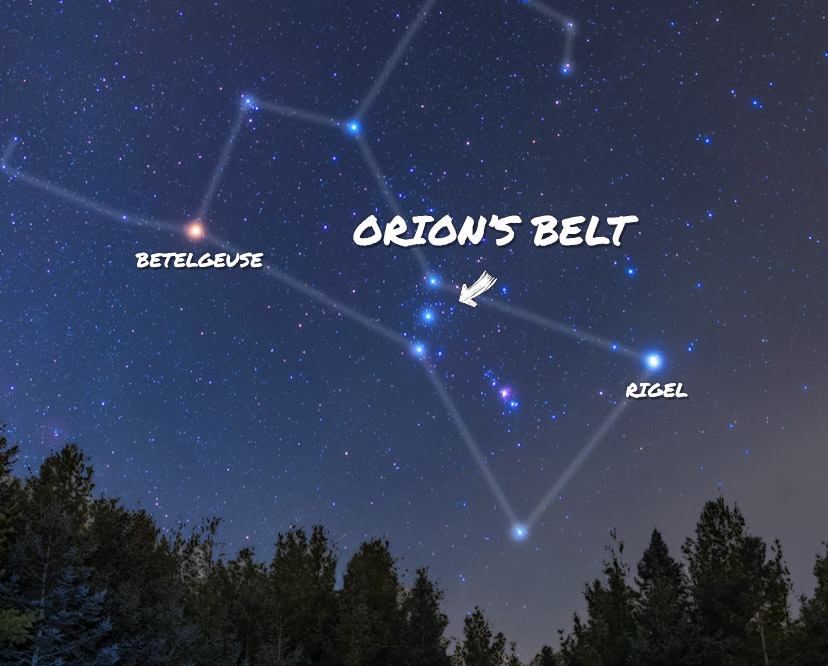Rigel | Orion’s Brightest Star
Rigel is one of the most noticeable stars in the winter sky. With an apparent magnitude of 0.12, it’s the brightest star in the Orion constellation and the seventh brightest in the night sky.
Rigel’s distance is approximately 860 light-years away from Earth, but because of its brightness and size, it is easy to spot with the naked eye. Its blue-white glow comes from its extremely hot surface temperature of over 11,600°C (21,000°F). It’s also massive, about 70 times larger than the Sun, making it a true giant among stars.
Rigel is the bright star at the lower right of the constellation Orion.
Rigel’s Characteristics
- Constellation: Orion
- Star Type: Blue Supergiant
- Brightness: Apparent magnitude: 0.12. Absolute magnitude: -7.84
- Color: Blue-white
- Surface Temperature: 11,600°C (21,000°F)
- Size: Radius 70 times larger than the Sun
- Luminosity: 120,000 times more luminous than the Sun
- Distance from Earth: 860 light-years away
- Mass: 18-24 times the mass of the Sun
- Stellar System: Multi-star system (Rigel A, B and C)
- Right ascension: 5 hours 14 minute 32.3 seconds
- Declination: -8 degrees 12 minutes 6 seconds
Rigel’s Bayer designation is β Orionis, which is Latinized as Beta Orionis and is often shortened to Beta Ori or β Ori.
The “beta” label is usually given to the second-brightest star in a constellation, but Rigel almost always outshines the red supergiant α Orionis (Alpha Orionis), better known as Betelgeuse.
It’s believed that Rigel got its ‘beta’ designation from Johann Bayer during a rare time when Betelgeuse, a variable star, was temporarily brighter.
The International Astronomical Union (IAU), which is responsible for standardizing star names, formally approved the name ‘Rigel’ in 2016 as part of its efforts to ensure consistent naming for celestial objects.
How To Find Rigel
To find Rigel, start by locating the constellation of Orion, which happens to be one of the most well-known star patterns in the night sky. Look for Orion’s Belt, a straight line of three bright stars in the middle of the constellation.
Once you find the belt, look downward (to the right if you’re in the Northern Hemisphere) to the lower part of Orion, where you’ll see a bright blue-white star—this blue star is Rigel, marking the ‘left foot’ of Orion.
You can see Rigel in the night sky during the winter months, especially from December to March. In the Northern Hemisphere, it’s visible low in the southeastern sky in the evening, while in the Southern Hemisphere, it appears high in the northeastern sky.
Although Rigel isn’t directly linked to the Orion Nebula (Messier 42), its brightness helps make the entire Orion constellation easier to spot, helping stargazers find objects.
Rigel is also one of the vertices in the Winter Hexagon asterism, which includes other stars like Aldebaran, Capella, Pollux, Procyon, and Sirius.
Rigel’s Binary System
Rigel isn’t a single star—it’s part of a multiple star system that includes three or more stars. It consists of a blue supergiant star (Rigel A) and two other main sequence stars (Rigel B and Rigel C).
Rigel B is much smaller and dimmer. Though Rigel B is hard to see because of Rigel A’s brightness, it is located about 9.5 arcseconds from the main star.
It was later suspected that Rigel B was a binary system (two stars bound by gravity) and was split into two components, Rigel B and Rigel C, which appear almost identical with visual magnitudes of 75. and 7.6.
Rigel’s Spectral Class
Rigel is part of the spectral class B8Ia, meaning it’s a blue supergiant.
The “B” means that Rigel is a hot star that is blue-white in color, and the “8” means it’s cooler compared to other B-type stars, but still hotter than most stars.
The “Ia” tells us that Rigel is a supergiant, which means it’s very big and bright. This happens after a star has used up most of its hydrogen fuel and moved on to a later stage in its life.
The Life Cycle of a Blue Supergiant
Blue supergiants, like Rigel, are among the most short-lived stars in the universe.
They start by burning through hydrogen at an incredibly fast rate, leading to their intense brightness and heat. As they age, they exhaust their hydrogen fuel and begin fusing heavier elements. This causes them to swell in size and become even more unstable.
Eventually, stars like Rigel will reach the end of their life in a dramatic explosion called a supernova. This explosion scatters the star’s outer layers into space, leaving behind a dense core.
Rigel could either become a neutron star (an incredibly dense object made mostly of neutrons) or collapse even further into a black hole (a region of space where gravity is so strong that not even light can escape).
Astrophotography
The best time to capture Rigel is in the winter, during the months of December to March, when the constellation Orion is prominent in the night sky. Here in the northern hemisphere, keep an eye out for Orion rising in the Southeast.
If you’re looking to capture Rigel with the entire Orion constellation, a focal length of 50-100mm will work. If you’re aiming for greater detail, 200-400mm will allow you to capture the star clearly while still giving the option to include surrounding stars or part of the Orion constellation.
Rigel forms a striking contrast with Betelgeuse, the red supergiant marking Orion’s shoulder. Together, these two stars create a visually stunning scene in the night sky.
Keep in mind, that due to its brightness, capturing Rigel with nearby celestial objects can be challenging. It can be hard to balance the exposure of your image, as overexposing can cause it to appear blown-out, causing you to lose detail. Finding the right exposure to capture both Rigel and the Orion Nebula can be tricky, though shorter exposures and filters can help.
The Witch Head Nebula with Rigel at 260mm focal length (William Optics Pleiades 68).
For example, capturing Rigel with the Orion Nebula creates an interesting composition, contrasting the bright star with the glowing nebula.
The Witch Head Nebula, also known as IC 2118, is an incredibly faint reflection nebula. It’s illuminated by the nearby supergiant star Rigel in the constellation Orion, giving it its eerie, ghostly appearance.
Due to its faintness, capturing the Witch Head Nebula can be a challenge. However, the glow from Rigel helps make it more visible, especially with longer exposure shots.
Mythology and Cultural Significance
The name Rigel comes from an Arabic phrase meaning ‘the left leg of the giant,’ or the ‘foot of the giant’ which is referring to the figure of the Orion constellation.
In various cultures, Rigel holds different symbolic meanings. In ancient Greek mythology, Orion was a mighty hunter, and Rigel represented one of his steps across the sky. Many other cultures, including those in the Middle East and Indigenous peoples in North America, have woven Rigel into their celestial stories.
Rigel has also been important for navigation throughout history due to its brightness and position near the celestial equator. As such, sailors in both hemispheres have relied on this guide star.
Conclusion
Rigel’s brightness, size, location, and cultural significance make it one of the most fascinating stars in the night sky. Whether you’re a stargazer or an astrophotographer, don’t miss the chance to observe this giant star during the winter months.
Ashley is an environmental educator, communication professional, and astrophotographer. She has extensive experience writing for diverse audiences to increase public awareness and engagement. Ashley is an active Advocate and Delegate with DarkSky International, helping to protect the nighttime environment from the harmful effects of light pollution through advocacy and outreach.




